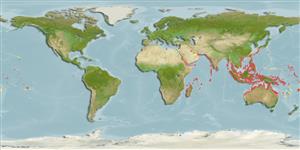Common names from other countries
Environment: milieu / climate zone / depth range / distribution range
экология
морской ассоциированный с рифами; пределы глубины 3 - 20 m (Ref. 90102). Tropical; 36°N - 31°S, 30°E - 146°W
Indo-West Pacific: Red Sea and East Africa to New Caledonia and Vanuatu, north to southern Japan. Reported from Fiji and Tuvalu (Ref. 12596).The exact range is uncertain because of confusion of this species with Sphyraena jello and Sphyraena qenie (Ref. 9768).
Size / Вес / Возраст
Maturity: Lm ? range ? - ? cm
Max length : 90.0 cm TL самец/пол неопределен; (Ref. 2334); common length : 60.0 cm TL самец/пол неопределен; (Ref. 9768)
колючие лучи спинного плавника (общее число) : 6; членистые (мягкие) лучи спинного плавника (общее число) : 9; колючие лучи анального плавника: 2; членистые (мягкие) лучи анального плавника: 7 - 9. Many typical chevron dark markings crossing lateral line on body; caudal fin largely blackish. No gill rakers on first arch, upper and lower gill arch with rough platelets, each platelet not bearing distinct spine.
Found near prominent current-swept lagoons or seaward reefs (Ref. 9710). Also in bays and inner turbid lagoons (Ref. 9768). Nocturnally active, but occurring in relatively large schools during the day (Ref. 9768). Sold fresh or processed into fish cakes (Ref. 27550).
Life cycle and mating behavior
Maturities | размножение | Spawnings | Egg(s) | Fecundities | личинки
Randall, J.E., G.R. Allen and R.C. Steene, 1990. Fishes of the Great Barrier Reef and Coral Sea. University of Hawaii Press, Honolulu, Hawaii. 506 p. (Ref. 2334)
Статус Красного Списка МСОП (Ref. 130435)
CITES (Ref. 128078)
Not Evaluated
Угроза для людей
Harmless
Использование человеком
рыболовство: коммерческий; объект спортивного рыболовства: да
дополнительная информация
инструменты
Специальные отчеты
Скачать в формате XML
ресурсы в Интернет
Estimates based on models
Preferred temperature (Ref.
115969): 24.5 - 29.3, mean 28.4 (based on 3674 cells).
Phylogenetic diversity index (Ref.
82804): PD
50 = 0.5000 [Uniqueness, from 0.5 = low to 2.0 = high].
Bayesian length-weight: a=0.00759 (0.00466 - 0.01235), b=2.92 (2.78 - 3.06), in cm Total Length, based on LWR estimates for this species & Genus-body shape (Ref.
93245).
Trophic level (Ref.
69278): 4.5 ±0.0 se; based on diet studies.
устойчивость к внешним воздействиям (Ref.
120179): средний (среднего размера), минимальное время удвоения популяции 1.4-4.4 года (K=0.3).
Fishing Vulnerability (Ref.
59153): Moderate vulnerability (36 of 100).
